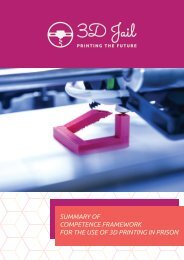3D Jail Project - IO1 - Competence framework for 3D printing in jail
Intellectual Output 1 The main innovative element of IO1 is to entail professionalizing competencies on the use of 3D printing technologies in the learning context of people with fewer opportunities because of their status of prisoners, ex-prisoners or subjected to alternative measures to detention. It is innovative because – in a pioneering way in Europe – it puts the basis to frame this kind of competencies in relation with restricted people, in the context of prison security, and it challenges penitentiary administrations to innovate their procedures and conditions to use even more ICT technologies inside their structures. It also poses prisons’ educational systems before the challenge to include these specific competencies in the educational experience of the inmates.
Intellectual Output 1 The main innovative element of IO1 is to entail professionalizing competencies on the use of 3D printing technologies in the learning context of people with fewer opportunities because of their status of prisoners, ex-prisoners or subjected to alternative measures to detention. It is innovative because – in a pioneering way in Europe – it puts the basis to frame this kind of competencies in relation with restricted people, in the context of prison security, and it challenges penitentiary administrations to innovate their procedures and conditions to use even more ICT technologies inside their structures. It also poses prisons’ educational systems before the challenge to include these specific competencies in the educational experience of the inmates.
- No tags were found...
You also want an ePaper? Increase the reach of your titles
YUMPU automatically turns print PDFs into web optimized ePapers that Google loves.
Comparability of qualifications<br />
extent to which it is possible to establish equivalence between the level and content of qualifications<br />
(certificates, diplomas or titles) at sectoral, regional, national or <strong>in</strong>ternational levels.<br />
Comment: comparability of qualifications improves <strong>in</strong>dividuals’ employability and mobility. This term must<br />
not be confused with ‘equivalence of qualifications’ (which refers to the similarity of value of certificates<br />
or diplomas).<br />
Source: Cedefop, Bjornavold, Tissot, 2000<br />
Recognition of learn<strong>in</strong>g outcomes<br />
<strong>for</strong>mal recognition: process of grant<strong>in</strong>g official status to knowledge, skills and competences either<br />
through:<br />
• validation of non-<strong>for</strong>mal and <strong>in</strong><strong>for</strong>mal learn<strong>in</strong>g;<br />
• grant of equivalence, credit units or waivers;<br />
• award of qualifications (certificates, diploma or titles).<br />
and/or<br />
Social recognition: acknowledgement of value of knowledge, skills and/or competences by economic and<br />
social stakeholders.<br />
Source: Cedefop, 2008.<br />
Certificate / Diploma / Title<br />
an official document, issued by an award<strong>in</strong>g body, which records achievements of an <strong>in</strong>dividual follow<strong>in</strong>g<br />
assessment aga<strong>in</strong>st a predef<strong>in</strong>ed standard.<br />
Source: Cedefop, 2008.<br />
Certification of learn<strong>in</strong>g outcomes<br />
Process of issu<strong>in</strong>g a certificate, diploma or title <strong>for</strong>mally attest<strong>in</strong>g that a set of learn<strong>in</strong>g outcomes<br />
(knowledge, knowhow, skills and/or competences) acquired by an <strong>in</strong>dividual have been assessed by a<br />
competent body aga<strong>in</strong>st a predef<strong>in</strong>ed standard.<br />
Source: Cedefop, 2008.<br />
Validation of learn<strong>in</strong>g outcomes<br />
confirmation by a competent body that learn<strong>in</strong>g outcomes (knowledge, skills and/or competences)<br />
acquired by an <strong>in</strong>dividual <strong>in</strong> a <strong>for</strong>mal, non-<strong>for</strong>mal or <strong>in</strong><strong>for</strong>mal sett<strong>in</strong>g have been assessed aga<strong>in</strong>st<br />
predef<strong>in</strong>ed criteria and are compliant with the requirements of a validation standard. Validation typically<br />
leads to certification.<br />
or<br />
Process of confirmation by an authorised body that an <strong>in</strong>dividual has acquired learn<strong>in</strong>g outcomes<br />
measured aga<strong>in</strong>st a relevant standard. Validation consists of four dist<strong>in</strong>ct phases:<br />
• identification through dialogue of particular experiences of an <strong>in</strong>dividual;<br />
• documentation to make visible the <strong>in</strong>dividual’s experiences;<br />
• <strong>for</strong>mal assessment of these experiences; and<br />
• certification of the results of the assessment which may lead to a partial or full qualification.<br />
Source: Cedefop, 2008; Council of the European Union, 2012.<br />
40





